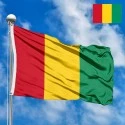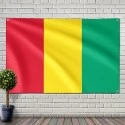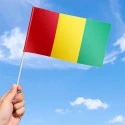The national flag of Guinea is a powerful and evocative symbol that embodies the nation's journey towards independence, its commitment to unity, and its aspirations for a prosperous and just society. Adopted on November 10, 1958, just weeks after Guinea overwhelmingly voted for independence from France and rejected membership in the French Community, the flag stands as a testament to the bold and decisive step taken by its people under the leadership of President Ahmed Sékou Touré.
Design and Symbolism: A Tricolor of African Pride and Progress
The flag of Guinea is a vertical tricolor, consisting of three equal vertical stripes of red, yellow, and green, from hoist to fly. Each color is laden with deep philosophical and historical meaning, reflecting the core principles that guided the nascent nation:
-
Red (Hoist Side): The red stripe, positioned closest to the flagpole, represents the sacrifice and the blood shed by the martyrs of independence, both during colonial struggles and in the pursuit of national liberation. It is a tribute to the valiant efforts and lives lost in the fight against oppression. Beyond this, red also symbolizes the toil of the working class and the nation's commitment to socialist principles and a revolutionary spirit. It embodies the courage and determination of the Guinean people. Red is also a traditional color of African liberation movements, linking Guinea to the broader Pan-African struggle.
-
Yellow (Middle): The central yellow stripe is a vibrant representation of the sun, the mineral wealth of Guinea, and the prosperity that the nation aspires to achieve. Guinea is rich in natural resources, particularly bauxite, gold, and diamonds, and yellow signifies this potential for economic development and improved living standards for its citizens. Furthermore, yellow symbolizes the radiance of African sunshine and the optimism for a bright future built on the nation's own resources and self-reliance. It reflects the idea that the nation's wealth should benefit all its people.
-
Green (Fly Side): The green stripe, at the outer edge of the flag, signifies the lush vegetation, the fertile agricultural lands, and the hope for a prosperous future rooted in the nation's rich natural environment. Guinea boasts extensive forests and agricultural potential, and green highlights the importance of agriculture as a foundation for national development and food security. It also embodies the hope and optimism for continued growth, environmental sustainability, and the well-being of the Guinean people. Green is often associated with the Islamic faith, which is prevalent in Guinea, and can also represent peace and harmony.
Together, these three colors form a cohesive and powerful visual statement, reflecting the Guinean national motto: Travail, Justice, Solidarité (Work, Justice, Solidarity). The colors, aligned with the Pan-African color scheme, further emphasize Guinea's solidarity with other African nations and its commitment to the ideals of African unity.
Dimensions and Proportions:
The official proportions of the Flag of Guinea are a width-to-length ratio of 2:3. This is a common ratio for national flags, giving it a balanced and visually appealing appearance. The three vertical stripes – red, yellow, and green – are of equal width, ensuring that each symbolic element receives equal prominence. This precise geometrical arrangement is crucial for the consistent and correct representation of this important national emblem across all official uses, from state ceremonies to international forums.
History and Evolution: A Symbol of Audacious Independence
The history of Guinea's flag is deeply intertwined with its unique path to independence from France, setting it apart from many other former French colonies in Africa.
-
French Colonial Period (Pre-1958): Prior to its independence, Guinea was part of French West Africa. During this colonial era, the official flag flown was the tricolor flag of France (blue, white, and red). There was no distinct Guinean flag recognized by the French authorities, as direct French rule aimed at assimilation rather than fostering separate national identities.
-
The Referendum of 1958 and the Birth of the Flag: A pivotal moment in Guinea's history was the constitutional referendum of September 28, 1958. French President Charles de Gaulle offered French African colonies a choice: either join the newly formed French Community, which would grant them internal autonomy while maintaining close ties with France, or vote "No" to the Community, which would mean immediate and complete independence, but also a complete break with France, including the cessation of French aid.
Under the charismatic leadership of Ahmed Sékou Touré, the leader of the Democratic Party of Guinea (PDG), Guinea was the only French colony in West Africa to vote overwhelmingly "No" to the French Community. This bold decision for immediate and unconditional independence was a momentous act of self-determination.
Following this historic vote, the newly independent Republic of Guinea needed a national flag. The design was quickly conceived, drawing heavily on the Pan-African colors (red, yellow, green), which were popularized by the flag of Ghana (which gained independence in 1957) and inspired by the Ethiopian flag, one of Africa's oldest independent nations. These colors had become symbols of African liberation and unity.
The choice of a vertical tricolor format, similar to the French flag, but with different colors and symbolism, can be seen as a subtle yet powerful statement: it acknowledged a historical connection while asserting a distinctly African and independent identity. The specific order of the colors (red, yellow, green from hoist to fly) was also carefully chosen to embody the national motto.
-
Adoption (November 10, 1958): The flag was officially adopted on November 10, 1958, barely a month after the "No" vote and the declaration of independence. This rapid adoption underscored the urgency and significance of establishing national symbols for the newly sovereign state. The flag became an immediate emblem of Guinea's courage, its non-aligned stance in the Cold War era, and its commitment to Pan-African solidarity.
The flag has remained unchanged since its adoption, reflecting the continuity of Guinea's foundational principles and its enduring legacy as a pioneer of uncompromising independence in Africa. It represents a proud legacy of self-reliance and sovereignty.
Regional Context and West African Identity:
Guinea's flag, while distinctly its own, is deeply interwoven with the broader vexillological patterns of West Africa and the Pan-African movement. Its design choices resonate with shared historical experiences and aspirations across the continent:
-
Pan-African Colors: The most striking connection is the use of red, yellow, and green, which are widely recognized as the Pan-African colors. These colors originated from the Ethiopian flag, symbolizing the blood shed for freedom (red), the mineral wealth and bright future (yellow), and the fertile land and hope (green). Guinea's adoption of these colors, following Ghana's lead, was a clear statement of its solidarity with other African nations striving for liberation and unity. Many other West African and African flags, such as those of Mali, Senegal, and Cameroon, incorporate these same colors, though often in different arrangements or with additional symbols.
-
Tricolor Format: While the colors are Pan-African, the vertical tricolor format itself is reminiscent of the French tricolor, which was common among former French colonies. However, by replacing the French colors with Pan-African ones, Guinea made a powerful statement of decolonization and the assertion of an African identity. This form of adaptation can be seen in other West African flags as well.
-
Symbolism of Liberation and Resources: Like many flags in the region, Guinea's flag explicitly symbolizes the struggle for independence (red for sacrifice) and the continent's rich natural resources and agricultural potential (yellow and green). This narrative of past struggles paving the way for future prosperity is a common thread in African national symbolism.
-
Pioneer of Independence: Guinea's flag holds a special place in the regional context as it represents a nation that chose immediate and complete independence, a path less taken among its French-speaking neighbors at the time. This bold decision solidified Guinea's position as a beacon of uncompromising sovereignty in West Africa and beyond, and its flag became a symbol of this defiant spirit.
-
Non-Aligned Movement: In the broader global context, Guinea's flag also implicitly represented its early commitment to the Non-Aligned Movement during the Cold War, asserting its independence from both Western and Eastern blocs, a stance consistent with its radical break from France.
Thus, Guinea's flag is not just a national emblem; it is a proud banner that aligns Guinea with the collective history, shared aspirations, and distinct identity of the West African region and the entire African continent.
Interesting Facts:
-
Uncompromising Independence: Guinea was the only French colony in West Africa to vote "No" to joining the French Community in the 1958 referendum, opting for immediate and total independence. Its flag thus symbolizes this unique and bold decision.
-
Rapid Adoption: The flag was adopted very quickly, on November 10, 1958, barely a month after the independence vote, highlighting the urgency of establishing national symbols for the new sovereign state.
-
Pan-African Colors: The flag uses the Pan-African colors (red, yellow, green), which represent the blood shed for freedom, the sun and mineral wealth, and the fertile land and hope, respectively. These colors are common in many African flags.
-
National Motto Embodied: The colors of the flag are said to embody the Guinean national motto: "Travail, Justice, Solidarité" (Work, Justice, Solidarity). Red for work/sacrifice, yellow for justice/wealth, and green for solidarity/hope.
-
Inspired by Ghana: The use of Pan-African colors in vertical stripes was partly inspired by the flag of Ghana, which gained independence a year earlier in 1957 and was a leading voice in the Pan-African movement.
-
Similarities with Mali and Senegal: Guinea's flag is very similar to the flags of Mali and Senegal. The Malian flag is also a vertical tricolor of green, yellow, and red (reversed order of green and red compared to Guinea). The Senegalese flag is also green, yellow, and red, but with a green star in the yellow stripe. This similarity reflects shared Pan-African ideals and the historical ties between these West African nations.
-
Ahmed Sékou Touré's Vision: The flag's design and adoption are strongly linked to the vision of Guinea's first President, Ahmed Sékou Touré, who was a staunch advocate for complete African independence and non-alignment.
-
No Changes Since Adoption: The flag has remained unchanged since its adoption in 1958, indicating a strong continuity in Guinea's national identity and principles.
-
Resource-Rich Nation: The yellow stripe particularly emphasizes Guinea's significant natural resources, including vast reserves of bauxite (a major source of aluminum), as well as gold and diamonds.
-
Agricultural Importance: The green stripe highlights the importance of agriculture to Guinea's economy and its potential for food security, given its fertile lands and tropical climate.
-
Symbol of Sovereignty: For decades, the flag has been a symbol of Guinea's uncompromising sovereignty and its determination to chart its own course without external interference.
-
International Recognition: The flag flies proudly at the United Nations and other international bodies, representing Guinea's status as a sovereign and recognized member of the global community.
Significance for the Inhabitants: A Banner of Identity, Sacrifice, and Enduring Hope
For the people of Guinea, their national flag is an immensely powerful and deeply cherished symbol that encapsulates their collective memory, their unique identity forged through courageous self-determination, and their enduring aspirations for a peaceful, unified, and prosperous future. It is far more than a mere piece of fabric; it is a vibrant narrative woven into the very fabric of a nation that took a bold and solitary path to achieve its independence and continues to strive for progress.
The red stripe, positioned closest to the hoist, resonates profoundly with the historical experience of the Guinean people. It is a constant and poignant reminder of the sacrifices and the blood shed by the martyrs of independence during their protracted and arduous struggle against colonial rule. This red color evokes a deep sense of gratitude and respect for those who laid down their lives, reminding every citizen of the high price of their freedom. It instills a sense of national pride in their courage and unwavering determination to choose a path of uncompromising sovereignty.
The central yellow stripe speaks to the promise of prosperity and the abundant natural resources of their land. Yellow, reminiscent of the sun's warmth and the richness of their soil, symbolizes the potential for economic development and a better life for all. It instills a sense of optimism for the future, highlighting the aspirations for exploiting their mineral wealth, achieving agricultural growth, and fostering economic stability. For the inhabitants, it represents the fruits of their labor, the wealth that belongs to all Guineans, and the hope for a thriving society built on justice and shared prosperity.
The green stripe, at the fly, reinforces this sense of hope and connection to the land. It symbolizes the lush vegetation, the fertile agricultural wealth, and the enduring hope for national development and a sustainable future. Green evokes the natural beauty of their country and the importance of their land for sustenance and progress. It is a symbol of growth, renewal, and the collective aspiration to build an environmentally conscious nation that thrives on its own resources. Furthermore, for many Guineans, green also holds religious significance, representing peace and the prevalence of Islam.
When unfurled during national celebrations, at educational institutions, or in moments of remembrance, the flag serves as a potent unifier. It transcends the complexities of regional and ethnic distinctions, fostering a shared sense of patriotism and collective destiny. It instills pride in their unique history of audacious resistance against colonial powers, acknowledges the struggles endured, and inspires a renewed commitment to building a future defined by peace, justice, and collective well-being. The flag of Guinea is, for its people, a living testament to their enduring resilience, their unwavering belief in the potential of their nation as a unified and proud African entity, and a constant reminder of the sacrifices that paved the way for their freedom and sovereignty.
In the demonstration images, full-size flags are shown with proportions of 2:3, and hand-held flags with proportions of 1:2.








 Waving flag
Waving flag
 Sizes:
Sizes:
 Round flag
Round flag
 Sizes:
Sizes:
 Rectangular flag 2:3
Rectangular flag 2:3
 Sizes:
Sizes: